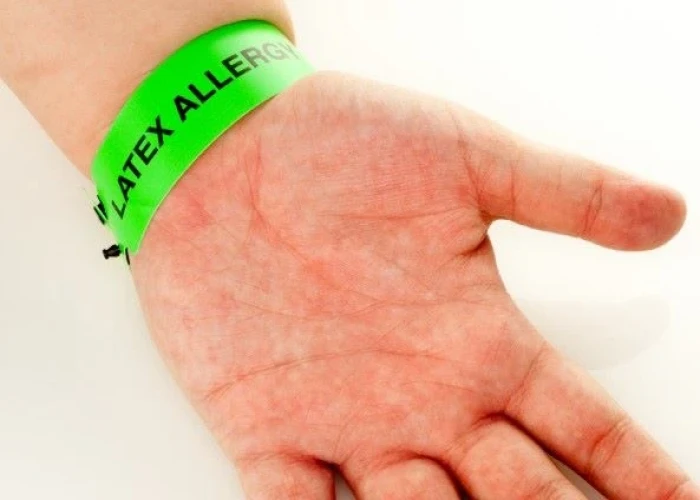 Welcome
Welcome
“May all be happy, may all be healed, may all be at peace and may no one ever suffer."
Latex allergy

Latex allergy is a reaction to natural rubber latex, which is derived from the sap of the rubber tree. Latex is commonly used in the production of gloves, balloons, and other products. Latex allergy occurs when the immune system reacts to the proteins in latex, causing symptoms that can range from mild to severe.
Symptoms of latex allergy may include:
- Skin irritation, such as a rash or hives
- Itching
- Swelling
- Runny nose or sneezing
- Red, watery eyes
- Asthma symptoms, such as wheezing or difficulty breathing
- Anaphylaxis, a severe and potentially life-threatening reaction that can include difficulty breathing, rapid heartbeat, and a drop in blood pressure
Latex allergy is more common in healthcare workers, as they are frequently exposed to latex gloves and other products. It can also occur in individuals who have had multiple surgeries or medical procedures, as they may have been exposed to latex repeatedly over time.
Diagnosis of latex allergy may involve a skin test or blood test to detect the presence of antibodies to latex. Treatment involves avoiding exposure to latex and using latex-free products, such as nitrile gloves or vinyl balloons. In cases of severe allergy, emergency treatment with epinephrine may be necessary.
Individuals with a latex allergy should inform their healthcare provider and wear a medical alert bracelet to alert others to their condition in case of emergency. They should also carry an epinephrine auto-injector at all times in case of severe reaction.
Research Papers
Disease Signs and Symptoms
- Itching
- Confusion (Hallucinations)
- Loss of consciousness (fainting)
- Dizziness (vertigo)
- Low blood pressure (hypotension)
- Cough
- Difficulty breathing (dyspnea)
- Scratchy throat
- Excessive tears in eyes
- Runny nose
- Frequent sneezing
- Skin rash
- Hives
- Red skin
- Weak pulse
Disease Causes
Latex allergy
In a latex allergy, your immune system identifies latex as a harmful substance and triggers certain antibodies to fight it off. The next time you're exposed to latex, these antibodies tell your immune system to release histamine and other chemicals into your bloodstream, producing a range of allergy signs and symptoms. The more times you are exposed to latex, the more strongly your immune system is likely to respond. This is called sensitization.
Latex allergy can occur in these ways:
- Direct contact. The most common cause of latex allergy involves touching latex-containing products, including latex gloves, condoms and balloons.
- Inhalation. Latex products, especially gloves, release latex particles, which you can breathe in when they become airborne. The amount of airborne latex from gloves differs greatly depending on the brand of glove used.
It's possible to have other skin reactions when using latex. They include:
- Allergic contact dermatitis. This reaction results from the chemical additives used during manufacturing. The main sign is a skin rash with formation of blisters 24 to 48 hours after exposure, similar to poison ivy.
- Irritant contact dermatitis. Not an allergy, this skin irritation is caused by wearing rubber gloves or exposure to the powder inside them. Signs and symptoms include dry, itchy, irritated areas, usually on the hands.
Not all latex products are made from natural sources. Products containing man-made (synthetic) latex, such as latex paint, are unlikely to cause a reaction.
Disease Prevents
Latex allergy
Many common products contain latex, but you can usually find a suitable option. Prevent an allergic reaction to latex by avoiding these products:
- Dishwashing gloves
- Some types of carpeting
- Balloons
- Rubber toys
- Hot water bottles
- Baby bottle nipples
- Some disposable diapers
- Rubber bands
- Erasers
- Condoms
- Diaphragms
- Swim goggles
- Racket handles
- Motorcycle and bicycle handgrips
- Blood pressure cuffs
- Stethoscopes
- Intravenous tubing
- Syringes
- Respirators
- Electrode pads
- Surgical masks
- Dental dams
Many health care facilities use nonlatex gloves. However, because other medical products may contain latex or rubber, be sure to tell doctors, nurses, dentists and other health care workers about your allergy before all exams or procedures. Wearing a medical alert bracelet can inform others of your latex allergy.
Disease Treatments
Although medications are available to reduce the symptoms of latex allergy, there is no cure. The only way to prevent a latex allergic reaction is to avoid products that contain latex.
Despite your best efforts to avoid latex, you may come into contact with it. If you've had a severe allergic reaction to latex, you may need to carry injectable epinephrine with you at all times. If you have an anaphylactic reaction, you will need to go to the emergency room for an immediate injection of adrenaline (epinephrine).
For less severe reactions, your doctor may prescribe antihistamines or corticosteroids, which you can take after exposure to latex to control your reaction and help relieve discomfort.
Disease Diagnoses
Disease Allopathic Generics
Disease Ayurvedic Generics
Disease Homeopathic Generics
Disease yoga
Latex allergy and Learn More about Diseases

Testicular cancer

Urinary incontinence

Breast pain

Mitral valve stenosis

Reactive arthritis

Floor of the mouth cancer

Posterior cortical atrophy

Blastocystis hominis
latex allergy, ল্যাটেক্স অ্যালার্জি
To be happy, beautiful, healthy, wealthy, hale and long-lived stay with DM3S.
